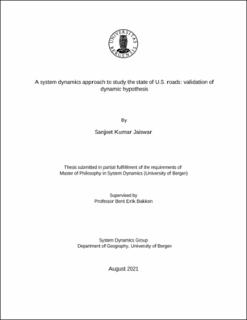| dc.description.abstract | The United States of America which has the world’s biggest road network, is falling behind when it comes to the condition of roads. The 2021 Report Card for America’s Infrastructure found the nation’s road infrastructure earns a cumulative grade of a ‘D’. Between 2000 and 2020, the percentage of roads nationwide in poor condition increased from 9% to over 22%. As the maintenance and rehabilitation needs grow, the challenge is that there is a gap between available funding for maintenance and the required cost of maintenance. Hence there has been an increasingly increasing backlog of deferred road maintenance. To study the problem, the system dynamics model of National highway system, following ageing-chain has been constructed. By making explicit the key feedback structure behind the ageing-chain-maintenance needs-maintenance budgeting system, the model reveals the reinforcing mechanisms caused by the rapid growth of new roads in early 50’s led to increase in the need of maintenance activities. During the 1950s and 1960s, U.S. investment in its infrastructure rose sharply, in part to meet the increased demands of the baby boom generation. Initiatives such as the interstate highway system also accounted for consistent increases in roads infrastructure spending. Since the 1970s there has been a decline in funding that supports the infrastructure of the United States. The decline in federal infrastructure funding continued during the 1980s as most of the wealth of the United States was devoted to consumption rather than to the enhancement of the nation's infrastructure. This declining funding caused to build lesser new roads and thus increasing the average age of US roads. The increasing average age caused an increase in maintenance demand and thus locking the road system into vicious poor maintenance cycle in USA. The model provides a simulation environment to examine the deteriorating condition of road, the increasing gap in maintenance funding and analyze how deferred maintenance affects road network performance in the long-term (National Research Council, 1979; Hunt P. et. al, 2001) The simulation shows that in base case scenario, given that the GDP grows as it has over past few years, the system will continue to increase the fraction of poor roads and will peak to 26% in 2030 and then slowly fall to 22% in 2050. | |
